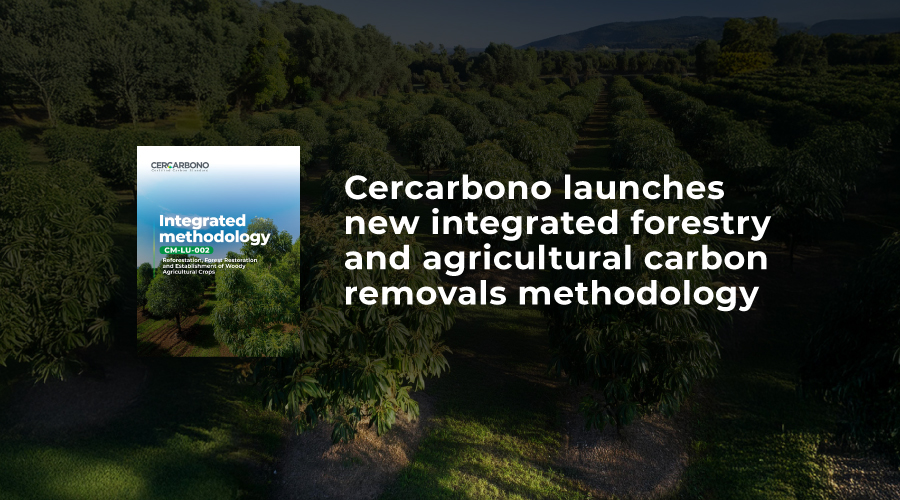News

04
Mar- Cercarbono’s new methodology integrates two land uses, forestry and agriculture, and three activity types, reforestation, forest restoration and establishment of woody agricultural crops, under one robust framework unparalleled in scope.
- Dynamic baselines and advanced mapping improve the accuracy of carbon removals while prioritizing native species increases ecological balance and long-term impact.
- Clear credit ownership evidences the mitigation results achieved and promotes inclusion and benefit sharing for stakeholders, especially Indigenous Peoples, local communities, and small landowners.
Bogotá, Colombia, 4 March 2025 – Cercarbono, a leading global environmental project certification standard, today unveiled its new integrated methodology for reforestation, forest restoration, and the establishment of woody agricultural crops. CM-LU-002 sets a new high bar for forestry and agricultural carbon removals. The methodology focuses on native species to improve ecological balance and resilience, clear credit ownership, and dynamic baselines to align claimed mitigation outcomes with an ever-changing environment.
This new methodology will empower developers with a single framework to implement a diverse range of projects. Its unparalleled flexibility allows for tailored solutions within a unified project or across separate areas. The methodology streamlines the process of credit certification and reduces the related costs. This approach, combined with its user-friendly design available in English and Spanish, will reduce barriers to access for all stakeholders, especially Indigenous Peoples, local communities, and small landowners, to help create a more inclusive voluntary carbon market.
Cercarbono has embedded the latest best practices within this single framework. In addition to focusing on native species, clear credit ownership, and dynamic baselines, the new methodology includes advanced cartographic tools for improved land eligibility, seamless adaptation to diverse geographical and ecological contexts, complements REDD+ by enabling crucial restoration work on non-forest lands, and integrates remote sensing and digital technology to enhance measurement, reporting, and verification (MRV).
Alex Saer, CEO, Cercarbono, said: “This methodology is a leap forward in carbon removal through nature. We’ve taken global best practice and listened to the needs of project developers and communities to create an approach that removes barriers, prioritizes real-world impact, and expands the potential for land-based climate solutions.”
Catalina Romero, Carbon Certification Director, Cercarbono, said: “By combining practical, developer-focused design with advanced technical features like dynamic baselines and enhanced cartography, we’re not just improving existing processes, we’re opening up entirely new avenues for impactful climate action.”
In incorporating dynamic baselines, rather than static ones, the new methodology provides a more accurate representation of carbon sequestration. Dynamic baselines adapt to changing environmental and socio-economic conditions over time, unlike static baselines, which can become outdated and overestimate impact. This, combined with the ability to utilise the latest digital MRV approaches, including remote sensing. When used conservatively and consistently with the methods and results reported by initial sources, this ensures that credits are based on realistic, conservative, real-time emission projections, aligning with the Integrity Council for the Voluntary Carbon Market’s quality recommendations.
Projects only deliver for the climate if they deliver for participating Indigenous Peoples and local communities. That is why the methodology guarantees clear and unambiguous credit ownership by implementing the Safeguarding Principles and Procedures of the Cercarbono Certification Programme. This gives communities and project owners full control and ensures they receive fair benefits. In addition, Cercarbono moves beyond traditional mapping tools by utilizing advanced cartographic techniques. These techniques pinpoint eligible project areas with exceptional accuracy, bolstering the integrity and credibility of the carbon credits generated.
Designed in consultation with project developers, the methodology is built to be user-friendly and to increase participation in the voluntary carbon market. The methodology’s clear criteria, practical examples, and an intuitive equational framework dramatically simplify the application process and make carbon crediting more accessible to small-scale developers and community-led initiatives.
Historically, non-forest restoration has not been possible with REDD+ project areas, but the methodology addresses this gap. Under strict double counting guidelines, it enables non-forest restoration activities to also be registered within existing REDD+ project areas, thus increasing the incentives for greater carbon sequestration.
Forestry and agricultural activity must often accommodate commercial plantations, but prioritizing native species in projects enhances ecological balance, strengthens ecosystem resilience, and provides crucial habitat for local wildlife. This methodology actively champions native species to lead to more sustainable and impactful long-term outcomes.
The new methodology will be available to project developers from March 2025.
About Cercarbono:
Cercarbono is an environmental project certification standard that accelerates high-integrity carbon, circular economy, and biodiversity projects. Established in Colombia in 2016, we are one of the three leading voluntary carbon standards worldwide. Leveraging our team’s multicultural expertise, firsthand knowledge of vital ecosystems, and predominantly Latin American presence, we bring an on-the-ground understanding of the requirements needed for successful climate initiatives. With over 200 global projects registered in more than 20 countries to date, our focus is on elevating the voices of underserved communities and helping them participate and actively shape environmental markets so that finance flows stay in the countries that need it the most.
